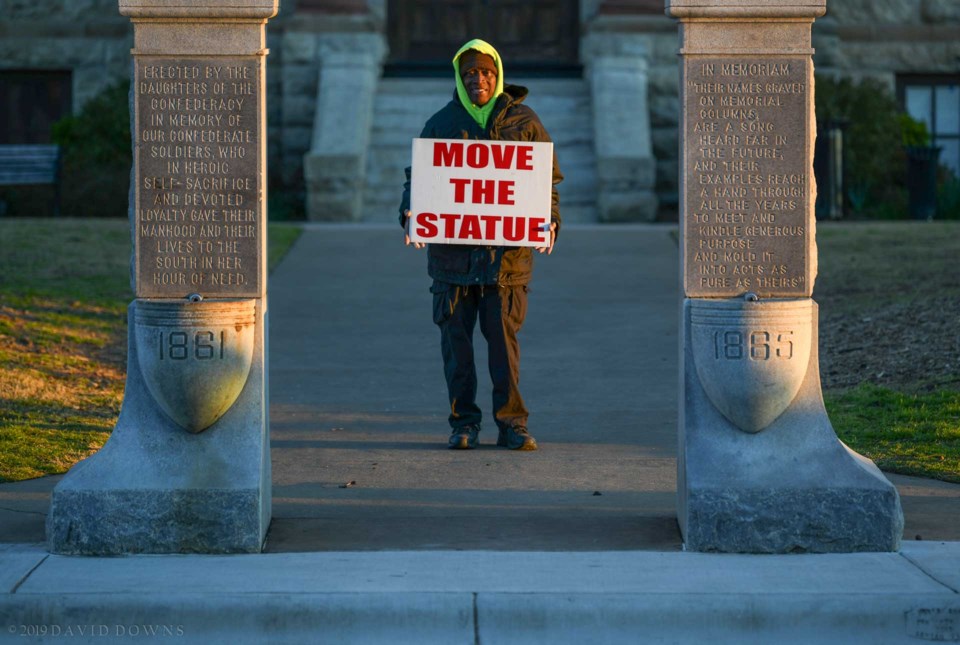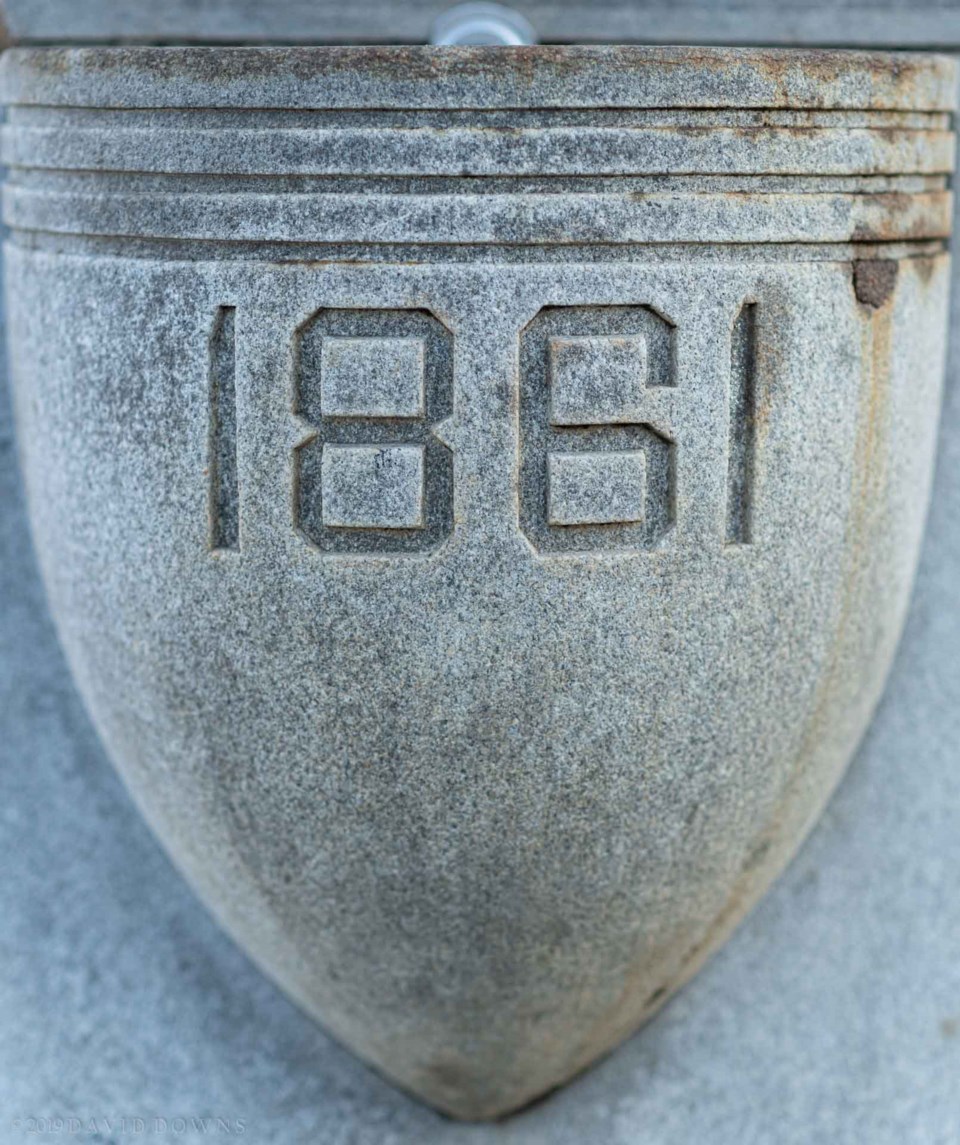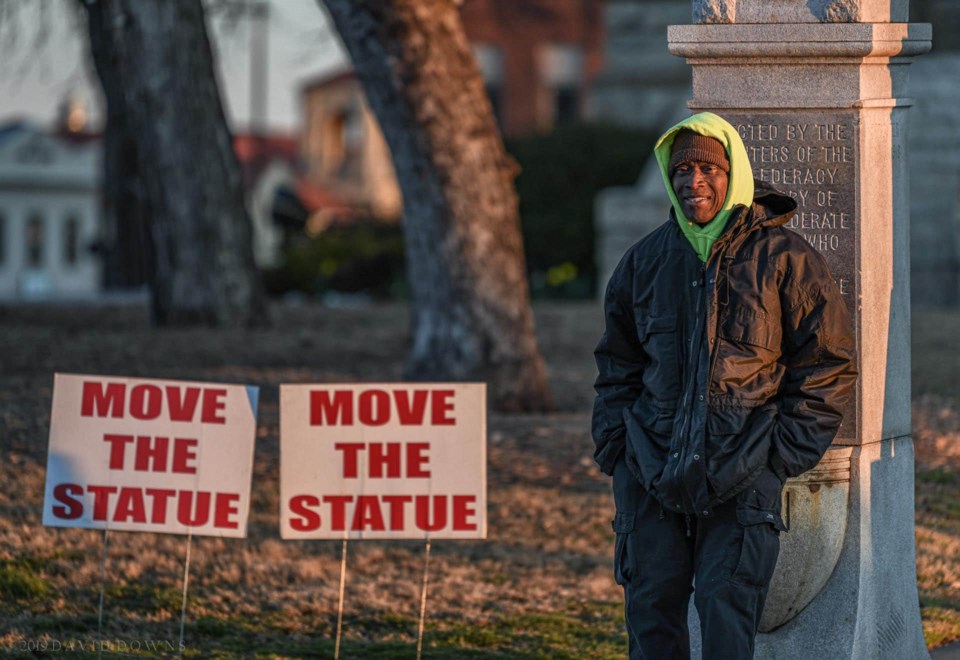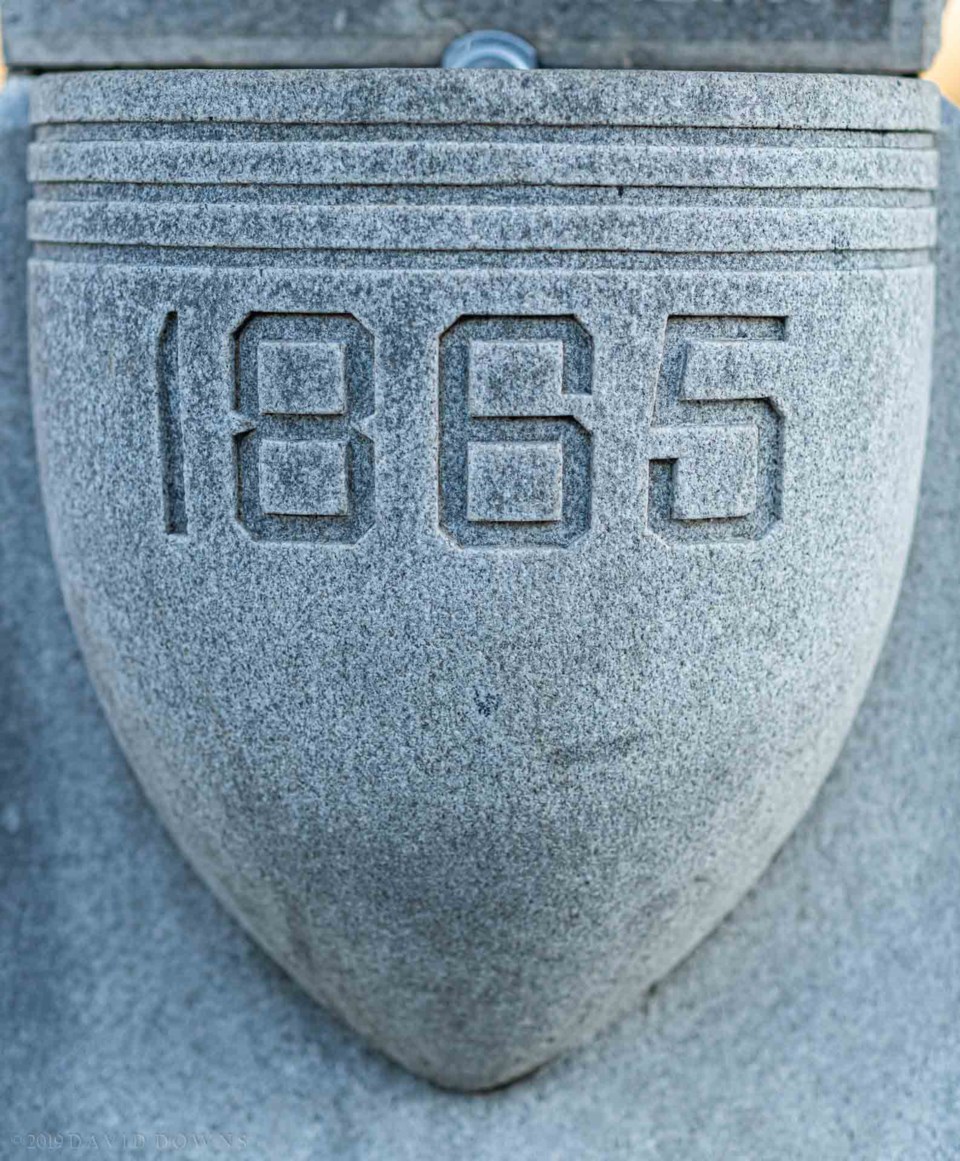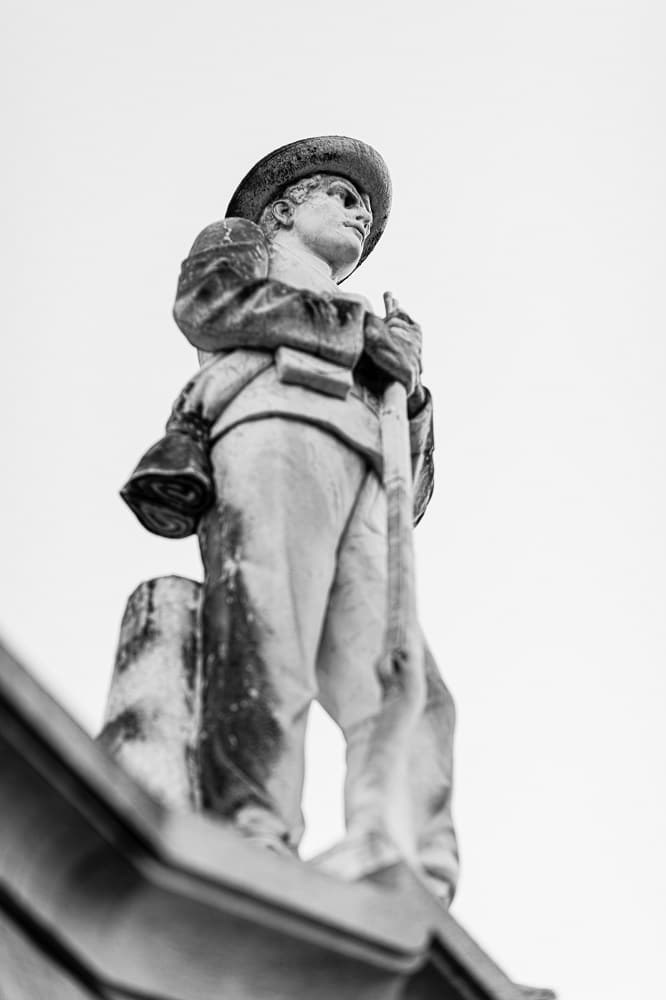A Confederate veteran’s son, cradling a black powder rifle, lingers near his Civil War wares, watching children slowly approach his memorabilia. Dressed in Wranglers, a collared shirt, and a farmer’s cap, he looks like a grandpa, kind of grumpy, but does his best to appear inviting when children approach. They linger in front of a white fold-up table for a minute or two, eyeing old pistols, rifles, and sabers. He leans over and gives them a small Confederate flag, a “Confederate Monuments Matters” button, and Confederate money with a mission statement. Then he tells them a story about Southern knights battling evil Northerners hellbent on ending their way of life. “It was an invasion, I tell you,” he thunders.
The children jump. People passing by turn the other way and disappear down a different aisle of vendors. Several vendors have pitched tents on the lawn in the center of town, selling candles, t-shirts, and freshly cooked food. About 1,100 people call this place home. Chico was once known as Wise County’s oil capital but now it is mostly remembered for the rock crushing plants surrounding it. Rock-crushed limestone mounds appear like mountains on the horizon, covering the town in a fine-layer of white dust. It blankets the trees lining Highway 101 on the way into town.
Not many stop by the white table where the Confederate veteran’s son lingers. Only a few, like myself, who are curious about the old pistols, and don’t mind the Confederate battle flags flapping in the wind, or his companion, grizzled and weathered, perched behind the white table like a vulture watching its prey. He’s probably a grandfather, maybe a great grandfather, and could be a farmer, too. He doesn’t say much, simply watches the Civil War weaponry and nods every once in while whenever his companion hits on a particular point about the South’s rebellion.
Confederate booths aren’t an unusual sight in this part of the country. They’ve been appearing in North Texas for more than 120 years. They usually appear at festivals and trade days in the rural areas of the state, selling hatred and pride for varying prices. It’s rare to see children gathered around them, allured by the dull steel of discarded weapons and the promise of something free.
Armed with a Nikon, I watch as the Confederate veteran’s son gives an old brown dollar bill, a silver coin, and a small Confederate flag to a child. It looks different than the ones my father sells at his gun shop. It’s white with a smaller version of the Confederate battle flag in the right-hand corner, similar to Mississippi’s state flag.
“That’s a nice-looking revolver,” I say, approaching the white table.
“Go ahead, pick it up,” he replies.
It’s far heavier than the revolver that my father gave me a few years ago. I lower it and shake my head. “I’m not sure how anyone could shoot it without breaking their wrist.”
“It’s not that bad,” he says. His wrists are three times the size of mine. He leans closer with a glint in his eye. “It’s blackpowder. Southern rebels carried it in the Civil War.”
I know I should be impressed by its size. Blackpowder revolvers are a rare commodity among the AR-15s saturating gun market for today’s youth. This one is a replica 1847 Walker Black Powder 44 caliber.
“My father would probably be interested in this gun,” I say. “He owns a gun shop in Granbury.”
“Oh yeah, what’s your father’s name?” he asks.
I tell him.
“I know John,” he says and smiles like a used car salesman. “He’s got a nice gun shop. What’s your name?”
I tell him.
“My name’s John…”
He offers his last name, but I don’t hear it. I’m staring at the Confederate memorabilia on the white table. A few buttons read, “Confederate Monuments Matter.” I repeat the words several times in my head and hesitate picking up the button. I’d never given much thought to Confederate monuments. I’d seen a few over the years, but never held a particular interest for them. I didn’t know much about the Confederacy, other than people’s insistence that the Civil War was a war over states’ rights instead of states’ rights to own slaves. The Southern states’ willingness to rebel and fight for their rights saturated the rural culture when I was growing up. In the ’80s, The Dukes of Hazzard, one of my favorite TV shows, showcased two rebels outrunning the law in “The General Lee,” an orange 1969 Dodge Charger with a Confederate battle flag painted on the top of the car. Of course, Lynyrd Skynyrd played before a Confederate battle flag backdrop. Dimebag Darrell Abbot was known to wield a Confederate flag on his Dean guitars. I didn’t think he was racist. I just assumed it was because he was from the South and in a Southern metal band known for its rebellious ways. It’s like my father says, If you’re white with family roots in the South, there’s a pretty good chance one of your ancestors fought for the Confederacy.
You also probably have an uncle or a cousin who drove around with a Confederate Flag mounted from a CB antenna in his pickup bed. “It’s heritage not hate,” I was told by family members and friends who wore Confederate flag bandanas and plastered “South will rise again” on their pickup windows.
However, if you’re black with family roots in the South, there’s a chance one of your ancestors was a slave.
Picking up one of the replica Confederate bills, I flip it over and read the words, “Sons of Confederate Veterans.”
“What is the Sons of Confederate Veterans?” I ask.
“We’re an organization of 30,000 members,” John replies. “We seek to preserve Confederate symbols and advance Southern traditions.”
They’re wanting to grow their organization, according to the replica Confederate bill. “If you are interested in perpetuating the ideals that motivated your Confederate ancestors, the SCV needs you,” it reads. “The memory and reputation of the Confederate soldier, as well as the motives for his suffering and sacrifice, are being consciously distorted by some in an attempt to alter history. A unique part of our nation’s cultural heritage will cease to exist unless the descendants of Southern soldiers resist those efforts.” It ends with a toll free number.
Like many Southerners, I always thought the Confederate monuments were memorials honoring the dead, regardless of the political reason they were fighting for. Then I met an old black activist named Willie Hudspeth who’s been fighting to remove the one in front of the Courthouse on the Square in Denton.
The Confederate Soldier Monument has been perched on the south side of the courthouse since the early 1900s. In Collin County, the same monument can be found at the city park in Farmersville, a small farming community about 19 miles southeast of McKinney. “I didn’t even know we had one,” says Collin County Judge Chris Hill, when I ask.
Nearly everyone who has been to Denton’s downtown square knows about the Confederate soldier perched high on his monument. Thousands pass by him each year. Willie has been fighting to remove him for 21 years. He’s had a couple of places in mind for where he’d like to move it—one which would anger staunch Confederate supporters—but has finally settled on the cemetery a few blocks south of downtown, the final resting place for most of the Confederate soldiers honored by the statue.
With Confederate History and Heritage Month in April, Willie is rallying supporters to begin protesting the Confederate Soldier Monument in Denton, while Confederate heritage groups like the Sons of Confederate Veterans prepare to honor their erections.
“I want it moved from this honorable position on the square, indicating we’re all in support of that when we’re not,” Willie tells a young college reporter as we walk out of the old courthouse on the square on a recent Tuesday morning in early February. “We now figured out that [the commissioners’ court] already knew before I presented them with the evidence, that the Klan was behind that statue.”
Rebels with a cause
He was the talk of the town. Armed with his trusty blackpowder rifle in parade rest position, the Confederate soldier started appearing in small towns around the South about 20 years after the Civil War ended in 1865. He stares straight ahead, brows narrowed, slightly frowning, his gray-regulated Confederate uniform unmarred from the four-year battle that divided a country, leaving 620,000 dead and 1.5 million wounded. Perched atop a granite platform, this Confederate soldier, colored like a stormy sky, was said to have been built to be a monument to the soldiers who sacrificed their lives for the South’s rebellion. These monuments were the crowning achievements of the United Daughters of the Confederacy chapters in places like Denton and Collin counties after a five-year struggle to raise funds.
Mostly middle and upper class white women, the Confederate Daughters held song and fiddle nights, collected donations at their children’s schools, and convinced county and state fairs to donate a portion of their ticket price for the statues. They claimed they were not only honoring those who died but those who survived, some of whom were still alive at the time. They erected 68 monuments in Texas in the early 1900s. Critics argue they were rewriting history by perpetuating the “states rights” message, papering over the “state rights to own slaves” one. In those days, not many people had access to Texas’ official declaration that spelled out clearly why the Lone Star State rebelled, joining other Southern states to form a Confederate nation:
“Texas abandoned her separate national existence and consented to become one of the Confederate States to promote her welfare, ensure domestic tranquility and secure more substantially the blessings of peace and liberty to her people. She was received into the confederacy with her own constitution, under the guarantee of the federal constitution and the compact of annexation, that she should enjoy these blessings. She was received as as commonwealth holding, maintaining and protecting the institution known as negro slavery—the servitude of the African to the white race within her limits—a relation that had existed from the first settlement of her wilderness by the white race, and which her people intended of the confederacy.”
Erecting Confederate statues also allowed the Daughters to escape their stereotypical roles in Southern society, according to “Sacred Memories: The Civil War Monument Movement” by Kelly McMichael. It gave them a sense of independence and reflected what would follow a year later when women across America demanded their right to vote.
An estimated 40,000 people attended the parade for the Confederate soldier monument unveiling in Dallas. Only about 8,000 people were living in Denton when the Daughters held the unveiling ceremony in early June 1918 nearly 20 years later. The Denton Record-Chronicle reported it was the perfect day for the ceremony due to Confederate States President Jefferson Davis’ birthday, and called the monument “a very beautiful piece of work.”
The Katie Daffan UDC chapter began collecting money for it in 1913, about a year or so after the Stonewall Jackson UDC chapter in Collin County started raising $2,500 to erect the Confederate soldier monument in Farmersville. The Collin County chapter collected mostly from individuals and a Confederate veterans group, while the Denton County chapter held pledge drives, hosted dinners, and sold pies, sandwiches, and candy to raise $719 of the $2,000 needed. Individual contributors such as Alliance Ice Company, the Denton County Bank, and the Exchange National Bank in Fort Worth helped fund the rest, as did supporters from Frisco, Lewisville, and Little Elm, giving mostly a buck or two for the cause.
“First of all, we are grateful to those who contributed of their means; to the editor of this paper and his staff of workers, who have been so generous in giving us space in the paper and so courteous in their business dealings with us,” the Kattie Daffan chapter president wrote in a June 7, 1918 Record-Chronicle article. “… To those teachers and children, who assisted us in our paper-gathering campaign, and contributed on Lee and Jackson memorial day. To everyone, who, at any time, assisted us in any manner. We thank all those who donated their services on Dedication Day, the Boy Scouts for invaluable assistance, M.B. Whitlock & Co. for erecting the platform, for those who loaned us flags.”
Nearly the whole town showed up for the unveiling. Some were Confederate veterans of the Civil War, singing Dixie because they would be remembered as Southern heroes. All were mesmerized by the statue’s craftsmanship.
Unlike Collin County’s monument, which is a simple Confederate soldier on a tall granite base, Denton County’s soldier perches atop a granite archway, the words “Our Confederate Soldiers” engraved across the bridge. Twin “white only” drinking fountains—1861 on one, 1865 on the other—protrude on each side of the archway’s base. The bronze placards above them read, in part: “In memory of our Confederate soldiers, who in heroic self-sacrifice and devoted loyalty gave their manhood and their lives to the South in her hour of need.”
In a Tuesday morning editorial in early June 1918, the editor of the Record-Chronicle wrote, “There aren’t many of the ‘old boys’ left now; a few more years and they will be extremely few. It’s good, then, to know that the monument sacred to their bravery and heroism is erected in time that some of them are living to see; a few years delay and it would have been too late.
“The South owes a debt to its Confederates it can never wholly repay; but the Daughters of the Confederacy have made some payment on that account by the handsome and enduring monument they have erected to the honor the veterans of ’61-65.”
Black pride
He wanted the Confederate soldier monument’s drinking water fountains turned on. Willie Hudspeth had been walking past them since he moved to Denton more than 40 years ago. He suspected the fountains had worked at one time, and had no doubt that the Daughters of Confederacy never intended for a black man to drink from them.
A former Black Panther, and a Vietnam veteran, Willie planned to let his granddaughter drink from them first.
He didn’t look at the statue in reverence like some of the county commissioners or the former county judge, Mary Horn, who called the monument a memorial to those who sacrificed their lives for the South’s Lost Cause: states’ rights to enslave black people. It was an unusual claim for the county judge to make since most people in North Texas probably can’t trace their roots back to Confederate veterans.
“It says to me: That we approved of slavering in Denton County,” Willie told me in a September 13, 2015 profile for the Record-Chronicle.
The 1990s had ended, and Texas legislators had recently passed legislation recognizing April as Confederate History Month when Willie, who was in his early 50s, walked into the old courthouse and addressed county commissioners. He claims he told them that turning the drinking fountains back on was the right thing to do since they were trying to touch up the statue. It was a longshot request. At that time, Denton County wasn’t known for its positive dealings with people of color. The late Sheriff Weldon Lucas had been accused of keeping black people out of upper level positions at the sheriff’s office in a Sept. 14, 2000 Dallas Observer cover story. And you would have been hard pressed to find anyone of color working at the District Attorney’s Office. Of course, Denton’s dealings with black people grows more frightening, like the rest of the South, as you travel back in time. The most infamous event is the Quakertown incident in the early 1920s, a few years after the Daughters of the Confederacy erected the Confederate soldier monument.
Southern blacks had established the community in the years following Reconstruction to escape former slave owners who were pressuring them to continue working despite earning their freedom after the South lost the war. A vibrant community subscribing to Booker T. Washington’s self-help philosophy, they built a grocery, a cafe, a black mortuary, as Denton History.com pointed out. A black doctor practiced medicine across the street from the grocery. Yet, they were no match for the Denton club women who wanted a city park like Dallas, which already had seven built at that time. A $75,000 bond was passed in April 1921 to buy out the black property owners in Quakertown. It was an underhanded move to force the black community away from the all-white women’s campus of the College of Industrial Arts, now known as Texas Woman’s University. The president at the time, F.M. Brailey, is quoted as saying that they would “rid the college of the menace of the negro quarters in close proximity to the college and thereby remove the danger that is always present so long as the situation remains as it is.”
By 1923, Quakertown had disappeared.
Nearly 80 years later, and a few blocks away from what is now known as Quakertown Park, Willie learned that the county judge was receptive to his idea of turning on the Confederate soldier’s drinking fountains. It took a few years, but Willie claims the county judge planned to turn them on. It wasn’t as big as surprise as you might expect. He was a Democrat.
Then he stepped down to run for another office, and Mary Horn, the “Queen of Denton County,” as her future commissioners would call her, won the Republican primary and ascended the county judge throne in 2002. She quickly reversed course on the drinking fountains and spent the next 16 years claiming they never worked. No water lines had been laid, she said.
The current county judge, Andy Eads, didn’t return calls for comment.
“Then, one day, the big dummies said, ‘We’re going to put this thing to bed,’” Willie recalls. “So they had somebody from Dallas come out with one of those sensory deals where they can see under the ground.” He starts laughing. “I was right there filming. Then he said, ‘There they are.’ And the proof that they were there, again, was in their records.”
The Awakening
He didn’t say anything when he pulled the trigger. Dylan Roof simply held his Glock .45, a birthday gift from his father, and pointed it at the dozen people standing in front of him with their eyes closed in prayer. It was a Wednesday night in the middle of June 2015, and they were members of the Emanuel African Methodist Church, a historic house of worship founded about 45 years before the Civil War. Booker T. Washington and Dr. Martin Luther King, Jr. had given sermons there. After her husband’s assassination, Coretta Scott King led 1,500 protestors to the church in support of hospital workers who were striking in Charleston, South Carolina. Nine hundred protestors were arrested, including the pastor.
At 21, Roof was a ninth grade dropout who had researched churches before the shooting. He settled on the Emanuel African Methodist because it was historic. “I think at one time it had the highest ratio of blacks to slavery,” he later told investigators.
The congregation had offered him kindness and given him sheet music to join in song when they stood and prayed. He fired 70 rounds.
Nine people were killed.
“Somebody had to do it,” he said shortly after confessing to police. “… Black people are killing white people every day. What I did is so minuscule compared to what they do to white people every day.”
After Roof’s arrest, photos of him posing with a Confederate battle flag and his Glock .45 resurfaced on the website “The Last Rhodesian,” a domain registered to Roof four months before he pulled the trigger. The author of the website called “blacks” a menace to society and defended segregation. “I chose Charleston because it is [the] most historic city in my state, and at one time had the highest ratio of blacks to Whites in the country,” he wrote. “We have no skinheads, no real KKK, no one doing anything but talking on the internet. Well [,] someone has to have the bravery to take it to the real world, and I guess that has to be me.”
The reaction was swift. People started paying attention to the symbols honoring Confederates who, despite what supporters say, fought for their state’s rights to own slaves. They realized that 150 years after the Civil War ended, Confederate memorials were still appearing around the country. NPR reported that a Sons of Confederate Veterans’ commander helped dedicate one three days after the Charleston church shooting. “It’s important that we remember the past,” he told NPR in a June 25, 2015 report. “I think in a world that we’re living now, where it seems everything sacred is being attacked one way or another, remembering those that went before us and died for a cause that they believed in is sacred.”
South Carolina Gov. Nikki Haley disagreed and removed the Confederate flag from the statehouse a few weeks later. “I think the more important part is it should have never been there,” she told CNN’s Don Lemon shortly after the flag’s removal. “These grounds are a place that everybody should feel a part of. What I realized now more than ever is people were driving by and felt hurt and pain. No one should feel pain.”
In the wake of the Emanuel AME church shooting, other municipalities agreed and began removing Confederate monuments and plaques. However, Confederate monument supporters weren’t sitting idly by. In August 2017, a few months after New Orleans removed its Confederate monuments, they held a Unite the Right rally in Charlottesville, Virginia, demanding Confederate monuments remain. It ended in violence.
Soon monuments across the South were toppling, including Confederate General Robert E. Lee’s statue in Dallas. Some could call it, “The Great Southern Awakening.” People began realizing they’d been fed a false narrative: the Confederate monuments have less to do with Southern pride and more to do with serving as a reminder that the South should have won and possibly could rise again, according to the Redeemers, a group of wealthy and upset southerners who formed shortly after the Civil War ended.
Willie knew it, felt it, had been trying to explain it for two decades. But his words fell on deaf ears until the protestors started joining him in the commissioners’ courtroom. Meetings began lasting far longer than usual. Then the media arrived and not just local but also national outlets, hip ones like Vice News. Willie read part of the inscription above one of the drinking fountains on the Confederate Soldier Monument for the Vice News reporter: “They gave their lives to the South in her time of need. What was her need? To have slaves.”
Judge Horn disagreed and told Vice News, “It was created by people who wanted to remember and memorialize their loved ones who were lost in the war. That’s it.”
She also argued that Willie was partly to blame for the delay in addressing the Confederate Soldier Monument because he kept changing his mind. “[For years] he was the only one [asking for its removal],” she explained.
After 16 years, Willie had given up on restoring the Confederate monument’s drinking fountains because the court wouldn’t budge on the issue. Instead, he figured if they wouldn’t turn them on, then they should at least move it away from the downtown square where a diverse group of people gathered on the courthouse lawn to hang out when the Texas weather permitted. Judge Horn, however, claimed that since the lawn was part of the old courthouse, it was also considered a museum; so the statue couldn’t be moved.
A few months after the Charlottesville incident, Willie knew this time would be different because he wasn’t alone in demanding its removal. Other protestors had joined him in the courtroom and on the courthouse lawn. Now the commissioners court was paying attention. Judge Horn announced they would form a special committee to determine what should be done with the monument and promised that Willie would be one of the first to join, as I wrote in a September 28, 2017 Dallas Observer article.
“I get my four minutes, and they shut me down,” Willie told me shortly after Judge Horn’s announcement and motioned toward the protesters surrounding him. “But this is not what they plan for. Heck, I didn’t plan for it either. This you got to deal with.”
20-Year War
Full of frustration and a hint of rage, Willie, now 74, gives his four-minute sermon to Denton County Judge Andy Eads and the commissioners. Two years ago, the Confederate Memorial Advisory Committee, which Willie is no longer part of, had given its recommendation to keep the Confederate monument on the courthouse lawn but have its racist origins explained with video kiosk. Still nothing has been done to the monument. It remains, its soldier standing tall, looking hungrily at LSA Burgers across the street.
A few months have passed since I met the Confederate veteran’s son at the festival in Wise County, and not many people fill the courtroom on this mid-February morning. Willie’s a familiar sight to most gathered here. He’s been standing here long before the county judge and many of the commissioners took office. Most are white, older men. Dr. Bobbie Mitchell, the former mayor of Lewisville, is the lone black woman on the court. She’s been serving as District 3 commissioner for 21 years.
Willie starts his sermon with a prayer, then delves into a topic we’re all familiar with. “There is a statue out front there of a Confederate soldier, and I’ve spoken to you several times over the years,” he says. “It seems like there is something behind that that’s not very good. Now I have the proof, and what I can’t understand is: you’ve been offered this proof several times, and you’ve ignored it several times; and you’re still pushing to keep that statue in that honorable position. Honorable? It’s on the town square, it sets up high, it communicates right on the front of it: Our Confederate soldiers. Who is ‘Our’? It most certainly isn’t me.”
Over the years, Willie has asked for the drinking fountains to be turned on and a bronze plaque with words he’d written placed, though he claims they changed his words before placing it a few feet away from the monument. He has also requested they move it inside the courthouse and recently suggested that they move it to the cemetery a few blocks away where the Confederate veterans were buried.
Yet, none of them are in favor of this idea. Judge Eads claims he’s following the advice of the Confederate committee and keeping the statue where it is located on the south side of the courthouse. They have a six-point plan of action and claim they might reconnect water to the fountains and may install a recessed six-foot granite memorial that denounces slavery through the archway of the existing Confederate monument. Denton County spokesperson Dawn Cobb claims the county has set aside $100,000 of taxpayer money to decry racism of the Civil War and the Jim Crow era. Former Judge Horn had told Vice News that her constituents didn’t want their tax money spent on the monument. “Donations are fine,” she claimed they told her.
However they decide to pay for it, their willingness to compromise seems fair, but critics claim it simply allows the Republican commissioners to retain their seats.
So instead, they wait patiently for Willie to finish what has become known as his Tuesday morning routine. “I know what the people who put that thing [the statue] up there stand for: the Klan,” he announces. “It’s the Klan. It’s tied in to what they did to the people in Quakertown.”
On the Confederate Memorial Advisory Committee’s website, commissioners point out a few of the non-racist things they’ve done over the years. They spent $475,000 on establishing the African American Museum, restoring the last Quakertown house, cleaning up a slave cemetery and dedicating historical markers for churches, buildings, and parks. “During African American Month in February, around Juneteenth and throughout the year, Denton County provides exhibits, lectures, programs, and special tours specifically designed to share the rich African American heritage across the county,” they write.
It doesn’t change the fact that commissioners and the county judge refuse to move a monument that the NAACP claims simply glorifies “treason and a hateful history of white supremacy and black subjugation.” The NAACP points out on its website, “In order for our country to move forward—to become a nation united and free from inequity and bigotry—we must remove Confederate symbols from the parks, schools, streets, counties, and military bases that define America’s landscape and culture.”
It’s a point Willie has been trying to make for more than two decades.
“So I’m going to change it up. I’m going to change strategies.” Willie stops, takes a breath, kind of laughs and continues, “The point is, You’re not going to do a thing. The five of you sit there very respectfully, and you are not going to do a thing. Could do something. Just vote and you can make change. You’re not going to. The only way that we can have change here: the federal government.”
Willie goes on to explain that he is putting together a discrimination lawsuit to file against commissioners. “So I’m not talking to you anymore,” he tells them. “I’m talking to the people who see this tape. We’re raising money to get that attorney who will handle that.”
They’re also working to remove commissioners from office. Commissioner Hugh Coleman is facing a brutal battle from a challenger with more money.
“We’re going to remove him from office,” Willie said.
Coleman lost his election by a couple of hundred votes.
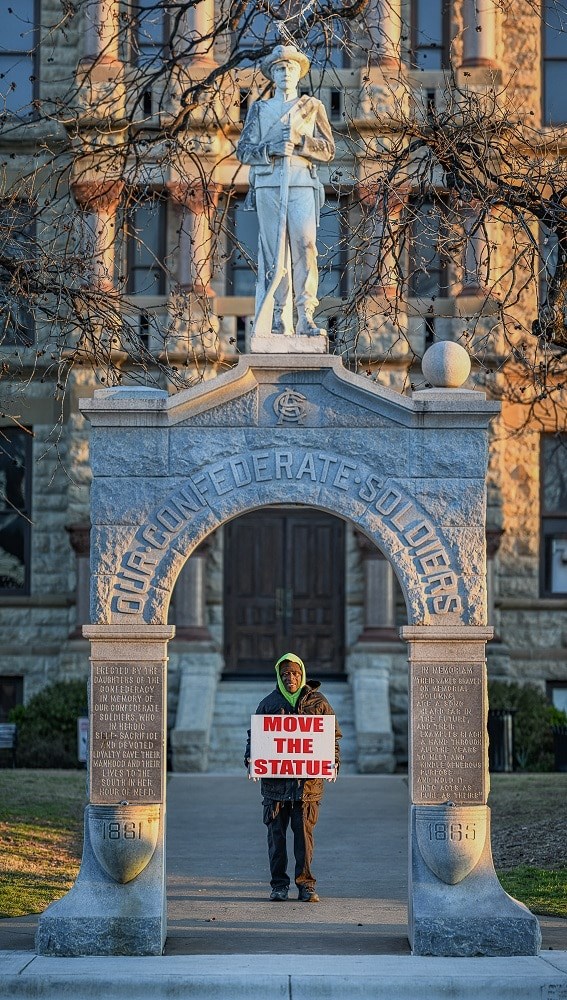
Down in History
After the meeting, Willie and I walk over to Cartwright’s Ranch House on the west side of the courthouse, chatting as if several years hadn’t passed since we last spoke. A place that offers a home-cooked Southern-style meal, the ranch house was originally part of downtown Denton’s “Theater Row” in the ’30s, ’40s, and ’50s. The brick wall in the back dining room was built about 15 years after the Civil War and showcases bricks that appear “glazed” from several fires that struck “Theater Row” in the previous century.
At 74, Willie moves slower yet seems determined and somewhat excited. In a bright yellow hoodie and black Vietnam veteran ball cap, he says he can feel change in the air and believes he still has a shot of getting the monument moved from the square, despite commissioners reiterating in news articles and on the Confederate Memorial Advisory Committee’s website that the committee “unanimously agreed the memorial should stay on the Courthouse-on-the-Square grounds.”
A couple of months ago, Willie discovered the Klan was involved with erecting the Confederate Soldier Monument. “I thought it all along,” he says over breakfast of toast and coffee with a shot of honey. “It was just frustrating because I didn’t have no proof. It sounded like something they would do. Now we know.”
In a December 3, 2019 Op-Ed for the Record-Chronicle, researcher Jessica Luther Rummel points out that the Denton chapter of the United Daughters of the Confederacy was named after Katie Daffan, the daughter of a first-generation Ku Klux Klan member, according to the Texas State Historical Association.
Daffan directed the UDC Denton chapter to erect the Confederate monument, Rummel points out from a 1910 Record-Chronicle report. “Contrary to modern assertions that the statue atop its arch reflects a memorialization of the ‘common soldier,’ UDC updates consistently refer to a ‘monument to the Confederacy,’ a ‘tribute to the Confederacy’ or a ‘tribute to the Confederate cause’ with occasional references to soldiers,” Rummel writes. “As it turns out, the soldier atop the monument is so common, an identical figure tops the Confederate tribute on Gainesville’s square.”
The UDC was also involved in the Quakertown campaign to move the thriving black community.
Willie shakes his head. “[The commissioners and county judge] kept hiding behind, ‘It’s a memorial to those soldiers who died, don’t you think they should be memorialized? They died fighting.’ But they’re not memorializing Hitler. It’s the same thing.”
Shortly after breakfast with Willie, I linger near the Confederate Soldier Monument on the old courthouse lawn. From where I’m standing, it isn’t hard to imagine him representing my Confederate ancestor on my father’s side of the family. Like the Confederate veteran’s son, I’m not sure why my ancestor joined the war. He could have been drafted. A year after the war started, men between the ages of 18 and 35 were required to be enrolled in the Confederate Army. More than likely, he volunteered like the 600,000 Southern boys looking for adventure in the first year of the war. Bored with farm life, some were passionate for the cause while others were angry that the federal government would try to tell them what they could or couldn’t do with those who they regarded as their property. I’d like to think my ancestor was one of the few who were pressured into Confederate service. He could have been a reluctant warrior, someone who felt a duty to family to defend their Southern honor.
But he was probably a racist. Most of them were. Racism was ingrained in the Southern culture. It was the whole reason they went to war. Small towns across the South celebrated it. They held barbecues and parades for the soldiers. Women handed out flags. Children waved them as the soldiers passed, daydreaming of fightin’ snowflake Yankees. It was nightmarish Norman Rockwell painting come to life when you consider the horror behind their smiles.
Nearly 160 years later, not many people who visit the downtown square where the Confederate soldier monument lingers pay much attention to it. It’s forgotten unless there’s a protest going on.
Willie has been protesting it on Sunday evenings off and on over the years, especially when the media climate is right. Sometimes he’ll come across a Confederate statue supporter who is always white and regurgitating familiar points commissioners have made in the past: “heritage not hate,” “erasing history,” “a memorial to fallen soldiers.” Yet, to Willie and others like him who grew up in the segregated South, it serves as a hateful reminder for those who are paying attention; it’s just hard to see when you’re white and from the South.
Originally appeared in the April print issue

